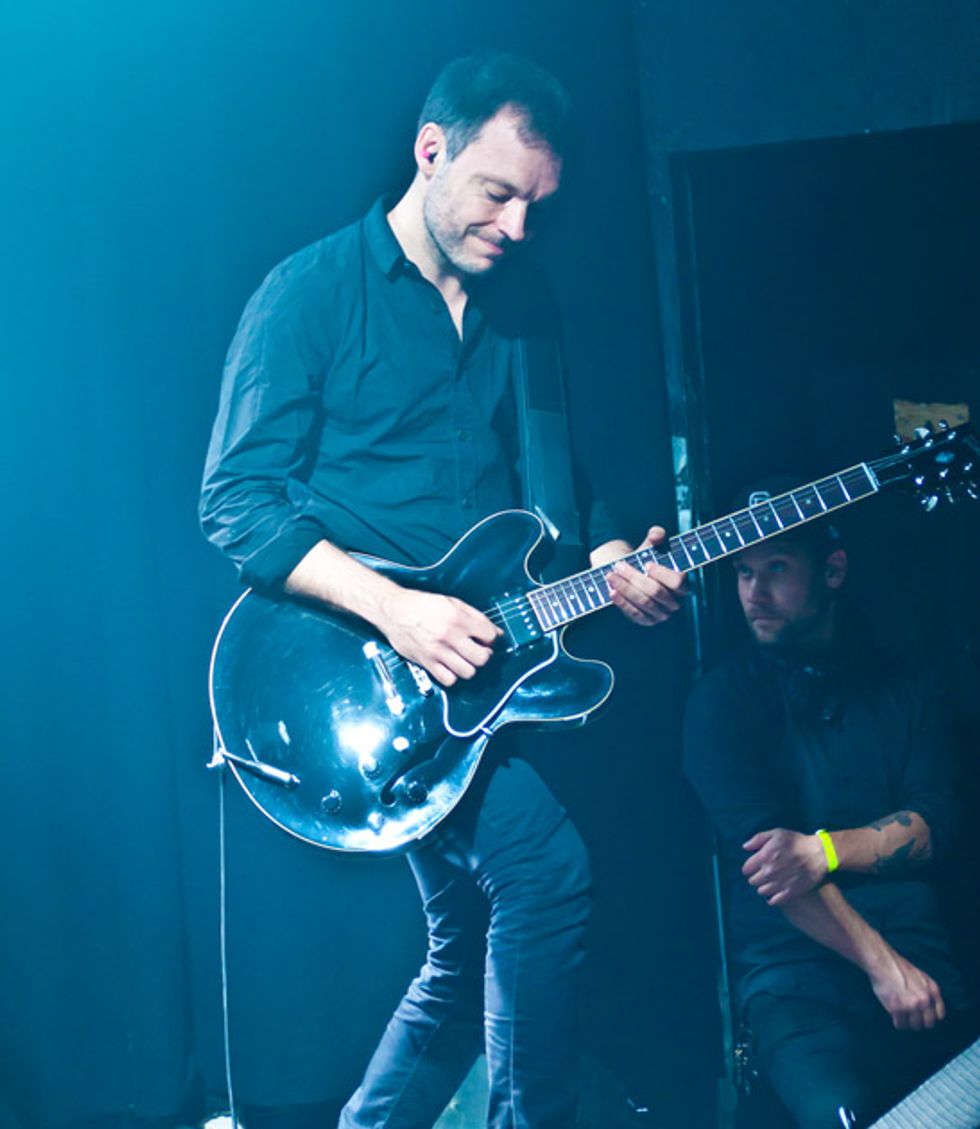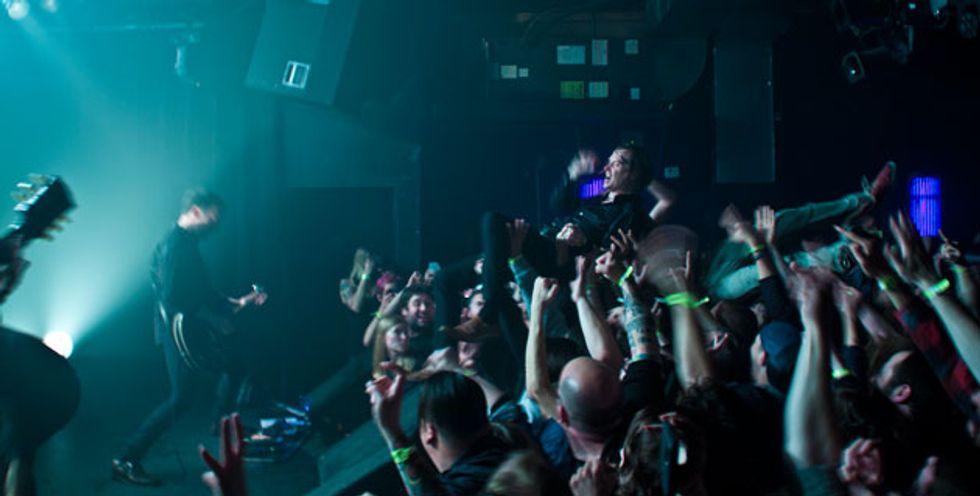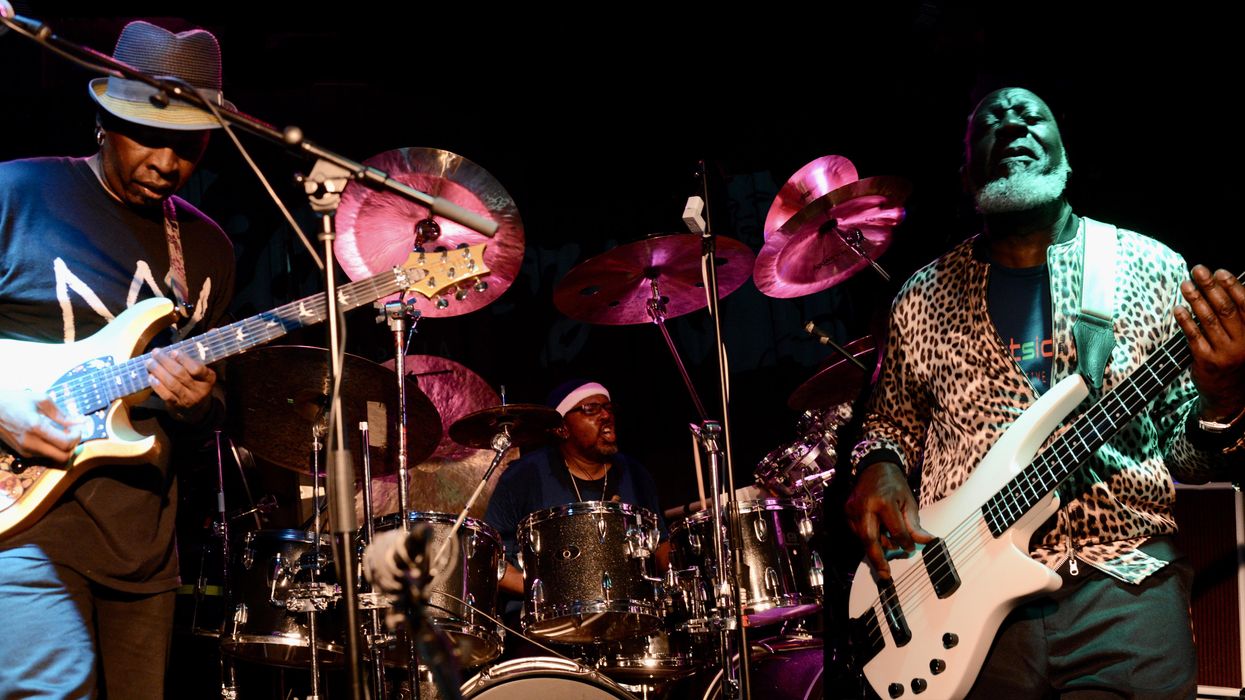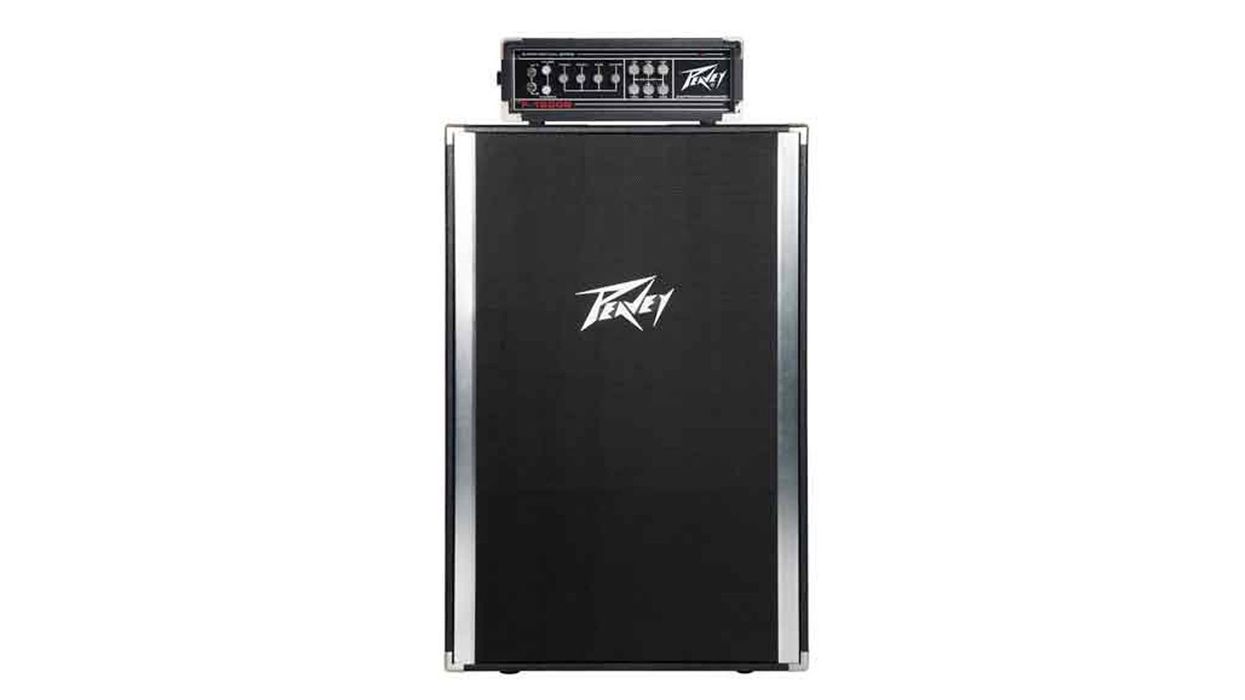Fans had been begging for it since 2004. They wanted metal-fused, hardcore band Refused to think about that dreaded r-word. Sure, reunions—even the ones where you have to congregate with distant relatives and blood-tied strangers in the dead of summer—can be a good thing. But reconnecting and celebrating the past doesn’t move people forward. No, the gents from Sweden were striving for another r-word—relevant.
“We enjoyed celebrating our past during recent years,” says guitarist Kristofer Steen, “but we’re really reenergized with the release of Freedom. We’re finally able to look forward rather than back in remembrance of things we did decades ago. We feel relevant now. We’re sharing our new music with fans at shows. As a band, we feel alive again.”
When we recently caught up with Steen before a Refused gig in Toronto, he opened up about the band’s history, explained why he loves both Gibson ES-335s and Les Pauls, and revealed what crucial advice he’d give his younger self.
How have the crowds been reacting to the new music on Freedom?
We knew going into the new record that it’d probably be a hard sell for the hardcore fans from the ’90s, or fans that only like a particular side of Refused, but we’ve never really been concerned with outside opinions. With any type of art, you can’t do it for anyone else or it feels forced or generic. I’m sure we’ve lost some fans who were really into The Shape of Punk to Come, but hopefully we’ve gained a few more with the release of Freedom.
What was your goal with the new music?
Well, I honestly thought—and I really got excited about the idea of it—the album would be very polarizing. People picked apart Shape when it came out, and I think when things are polarizing, you’re doing something right. So if anything, we wanted to surprise our audience and maybe make them question our musical decisions.
Given the 17-year gap between your last two albums, is there anything you hear in Freedom that was lacking in 1998’s The Shape of Punk to Come?
I’d say, probably a musical maturation. Shape’s dynamic shifts were very black and white—loud to quiet on a drop of a hat—and we wanted to have more building, brooding parts on Freedom to strike a more dramatic tone. We’ve already done Shape and it was something we collaborated on 17 years ago, so it’s inevitable we’d deviate from that formula.
One of the motifs in the documentary you directed, Refused Are Fucking Dead, was how the pressure you guys dealt with internally ultimately contributed to the band dissolving in the early 2000s. Was there any pressure around Freedom, given the unusual circumstances with the long hiatus and surprising return?
Any pressure we felt during the process of creating Freedom was put on us by each other—we don’t worry about what other people think. Our fans are pretty diverse in what they like about our band. Some might like the high tempo, aggressive parts, whereas others might like the slowed-down, melodic journeys or our experimentation with flutes and cellos. It was actually quite liberating to write whatever we wanted and know it’d be received as Refused. Plus, we expect people are going to be annoyed with certain parts or changes to our music, and it gets us off a little [laughs].
What broke the ice and got you guys talking again and ultimately onstage in 2012?
Well, it was definitely a long process. David [Sandström, drummer] was pretty much on friendly terms with everyone, so he was the social anchor for the band. Let’s be clear, there was never any bad blood, but we never really collectively hung out or spent time together after the breakup. Fast forward to about six or seven years ago, when we started receiving offers from tour promoters and festival organizers—it really messed with our heads.
How so?
Before that we never really felt the groundswell of anticipation or eagerness to have a reunion tour or do shows, but after seeing some of the offers we got, we got inflated egos and got enticed by the dollar sign … it just wasn’t us. Our initial reaction was to be flattered, but then we were insulted—as if we could be bought out. When you have those dollar signs looking at you, it can cross up your values.
How did it feel to make a film about your band dissolving in front of the camera?
Honestly, I approached it as a eulogy [laughs]. That’s pretty dark, but I wanted to show that any group of musicians—in our case, it was five normal guys from Sweden—can have an impact on the musical landscape. The feeling of the film is very dramatic and serious, but that was who we were as people back then. We were only focused on the music and the message. Nothing else really mattered or was even on our radar.
At times I had to detach myself and remember I was the director, but at other times, I had to realize I was the guitarist for this band. It was a tough line to walk. I think we all felt it was a good exercise because a lot of the interviews were shot during our final tour, so even then we felt a sense of impending doom and finality to the band. We were like a cult. Even off the road, we only hung out with our bandmates and crew—it became insanely claustrophobic. By the end, we had no oxygen.
If you could reach back to 1998, what would you tell your younger self?
Oh man, I don’t know if he’d listen to me, but I’d probably say, ’Chill out and just relax—everything doesn’t have to be that serious.’ Back then, we had some serious delusions of grandeur. That said, I don’t know if we could’ve created The Shape of Punk to Come if we hadn’t been angry, serious, fed up, and looking to lash out.
We needed to not give a fuck because otherwise we would’ve never put cello, horns, flute, or samples on a hardcore record. We were pretentious as hell [laughs]. However, the success of the album and the empowering idea of flying the finger in front of musical convention helped lead to our internal demise.
Steen recently got turned onto Gibson ES-335s and has really enjoyed playing them live because, "It howls, screeches, barks, and gives me everything the Les Paul can and more sometimes. It has a full, thick, rich tone that is just a different flavor than the Customs. " Steen is seen here with his 2000s ES-335 during a sold-out show in Chicago's Double Door on May 31, 2015. Photo by Chris Kies
When did the music start to happen again?
After we got those intriguing offers from festivals and tour promoters, David and I decided to start jamming. Not in a Refused or reunion context, but just to play guitar and drums together because we wrote a lot of the band’s material and we have a musical bond. I ventured up to his place and we started out playing really, fast, aggressive, thrashy Slayer-type songs. We had an absolute blast.
After a few jams, I asked him if he wanted to try something a little different, and he was really excited to hear it. What we fleshed out that day turned into “Elektra,” our first single. We probably came up with that four or five years ago.
The whole process was really organic. Had it felt forced, I don’t think I’d be sitting here talking to you about Refused or Freedom. I remember having a conversation with David while on our North American reunion tour in 2012. We acknowledged that all the time we’d spent playing together back in Sweden, when we thought we were jamming heavy, thrash songs for a new project, we were really writing Refused material. After that conversation in Toronto we actually went and wrote, “Thought is Blood,” for the new record, too.
Since David was in touch with everyone, did he let them know you guys were rocking out again?
Well, I had told our original bassist, Magnus Flagge, that David and I were working on something different together. Later that day Magnus texted me and said he’d just bought a new bass and wanted to jam with us. I remember thinking that I never really asked him to be in the band [laughs], but we got together and it was just three old Refused members hanging out and playing like old times.
A few years later Coachella came knocking again and the three of us had been jamming and rebuilding our chops, so it felt much more doable and not so desperate. Plus, we really felt this second-generation chemistry, so we just wanted to get out there and perform. We got Dennis [Lyxzén, singer] back into the mix, and we just figured, why not? So once we played a few festivals, it was obvious to us all that we should write a new record because we had so much fun performing the old stuff, but we truly enjoyed being around each other again. That re-bonding environment was really beneficial in creating Freedom and catalyzing the comeback. The money’s nice, but it’s not worth it if you hate what you’re doing or whom you’re doing it with.
Before the most recent reunion you were pretty loyal to Gibson Les Paul Customs, but when I saw you this May in Chicago you were playing an ES-335. Why the change?
No joke, I’m playing the Customs again.
Well, what did you like about the 335?
I really enjoyed its sound—especially live. I recorded mainly with the Customs and other solidbody guitars, but when I feel like fighting, I’ll bust out the 335 onstage because that’s where it comes alive. It howls, screeches, barks, and gives me everything the Les Paul can and more sometimes. It has a full, thick, rich tone that is just a different flavor than the Customs.
A lot of our music has really fast, dynamic tempo shifts and tight breaks, so the Les Paul is great for recording because you can get really quiet, really fast, whereas tracking with a 335 in our style of music causes things to sound sloppy or me to miss my cues because of its feedback. But when I play the 335 live, I really feel the extra noise and howling adds to the chaotic frenzy we produce onstage during a performance.
Kristofer Steen's Gear
Guitars
2000s Gibson ES-335
1990s Gibson Les Paul Custom
1990s Gibson Les Paul Traditional
2000s Fender Stratocaster
Amps
Vox AC30
’80s Mesa/Boogie Mark III combo
’80s modded Marshall JCM800
’50s Fender Twin (previously owned by Eric Clapton)
Effects
Boss BD-2 Blues Driver
Mad Professor Royal Blue Overdrive
MXR Phase 90
Dunlop Cry Baby 535Q
Strings and Picks
.010-.048 sets, any brand
Dunlop Tortex 1.14 mm picks
So did you track mainly with the Customs?
I used so many guitars, but I’d say the bulk of Freedom was done with my No. 1 Les Paul Custom from the ’90s.
I’m hearing some funky single-coils on “Servants of Death.” What did you use for that song?
For the clean, chk-chk riffing, it’s a Stratocaster, and for the distorted rhythm parts I actually used the 335.
What were you going after in that main clean riff?
Honestly, I just wanted to make Nile Rodgers proud [laughs]. He’s a one-man orchestra with that Hitmaker Strat. He’s the best. What I envisioned the guitar to sound like for “Servants” was a heavier, funk-guitar part you might find on Michael Jackson’s Off the Wall. Trust me, when I started playing around with that riff, I was very concerned not to come off as some white European who’s horribly trying to play funk guitar. You balance on the razor’s edge when you make any sort of funk music with a bunch of white Swedes [laughs]…
you just don’t want to look like assholes.
You guys like being out of your comfort zone.
Well, not all of us, and not all of the time. There’s usually one or two of us that is apprehensive about a lyric, or a breakdown, or instrumentation, but we usually talk it out and convince the unsure parties that everything will turn out and we’ll still sound like Refused.
What was an example of this during Freedom?
I remember with “Old Friends/New War” we had a lot of initial eyebrows raised. I had the idea of the completed, tracked song in my head, but when you’re at the rehearsal space it’s just guitars, bass, drums, and vocals, so it was hard for me to express everything I heard and saw being put into the final song. I knew all along that the drums would sound different, that we’d start with a modulated-voice intro, we’d have some extreme synth parts, and Dennis would have really dramatic vocal breakdowns. Everyone was kind of tepid about the song because it felt like a generic rock song and that’s definitely not us, but I convinced them that this will work out and to please trust me.
I think that’s what makes it one of my favorite Refused songs, period. How it turned out is almost identical to what I envisioned from the start. It was honestly a bit surprising how everything fell into place and it sounds like my idea. That usually never happens just because other people add better ideas, or halfway through you realize you can’t use that drum sound because it’s too harsh or distracting.
Steen using one of his '90s Gibson Les Paul Customs to track songs on Freedom. Photo by Dustin Rabin
In a band setting, is hard for you to push against the grain and go after something that is original or off the beaten path knowing the resistance you may face?
I wouldn’t say I was afraid of the other’s reactions, but the thing that always concerns me is resting on our laurels, or defaulting to something safe that we know is Refused. That scares me a lot—in this band and any artistic endeavor I’m involved in.
I think it’s in our nature to stay safe, but I think it’s our job as artists and musicians to fight that inclination and push through the uncertainties and questions. Don’t get me wrong, plenty of those unusual ideas don’t pan out, but it’s the practice of going against the safety-net mentality that makes even an unsuccessful attempt at something new worth the hassle and time.
“Old Friends/New War” ends with a killer, harmonized, phaser-rich riff that any guitar nut would love. What inspired you to throw that in there?
Again, I was just trying to emulate one of my heroes—this time it was Jimmy Page. One of my favorite things he’s put out is “Nobody’s Fault but Mine.” I absolutely love how that song starts with just him and his riffs. I tried to give Jimmy a tip of the cap by doing something similar to that song. We’re all really big Led Zeppelin fans, so everyone really enjoyed that part.
In all seriousness, when I came up with that part I wanted to bring it back to rock because up to that point, most of the song is hip hop orientated with the synths, the Afro rhythms, and electronic drum sounds. That riff brings it back full circle and propels the song to the end. Just imagine the song as a regular rock song and then that part at the end—it’d be a lot less impactful, and almost cliché, because it probably would sound like most of the song. I’ve learned differences work really well together.
In addition to Nile Rodgers and Jimmy Page, what are some of your other musical influences?
Well, those two are just phenomenal guitarists, but the reason I think they’re two of the best is because of their songwriting abilities and arranging chops. They’re amazing. Another artist that really excites me is Prince—his guitar work and compositions are unmatched. My favorite guitar album is probably Visions of the Emerald Beyond by Mahavishnu Orchestra with John McLaughlin and Ralphe Armstrong. I can’t say that album has been linked to any Refused songs like the other guys already mentioned [laughs].
Another person who inspires me is Kanye West. I’m sure people will roll their eyes, but I was really impressed with Yeezus because it was so forward-thinking, experimental, weird, and it incorporated so many new musical twists and chances. He’s such a bizarre, clown character on one hand, but on the other hand he’s a mastermind just like those other artists. It’s certainly a brave move for someone so mainstream and commercial.
Was Yeezus a reference point for some of the industrial-ish drums and rhythms on Freedom?
I wouldn’t say it was something we strived for and demanded, but you can hear the resemblance of that musical style in “Old Friends/New War.” Another hip hop reference—a more direct one—that we wanted to achieve is the snare-drum sound of Jay-Z’s “99 Problems” for “Françafrique.” The way the guitar riff works in “Françafrique”—I’d say it’s a combination of Hendrix’s “Stone Free” and “Freedom”—you need a compelling, contrasting element that makes it sound huge and fresh.
You’re more than just the band’s preliminary guitarist. You help orchestrate a lot of the instrumentation on Shape and Freedom. What do you enjoy about that side of the process?
I look at things from two perspectives—as a guitarist and as a song architect. What originally got me into music in high school and earlier was playing guitar and learning the songs of my heroes. I still really enjoy creating riffs and coming up with guitar parts, but anymore, I’m most excited about contemplating the greater picture and landscape of a song. A guitar is a tool, but a song is an experience and I like having a hand in creating a new listening experience for music fans.
Would you say the drive to participate in arrangements, songwriting, and the overall process was something fostered during Refused’s downtime?
I’ve always had an interest in everything beyond guitar playing, but I think directing plays and operas after Refused was finished was as big of an influence as anything else in my life. Working in that arena and format has really bolstered my eye for the overall project and message. I’ve really grown to appreciate the process and get creatively energized from putting the musical puzzle together.
“Destroy the Man” is a complicated number. How did you develop that song?
That song was like “Elektra” in that we came up with it during the basement Slayer jams at David’s. At that point, I was really into Robert Fripp and early King Crimson, so I crafted these weird chromatic figures and tried to warp them into a memorable riff. I think chromatic passages are generally very boring because they’re limited structures. David put together a really catchy, moving, danceable beat, and Dennis added those doo-wop background vocals to make the finished song have a bit more groove. This was probably the most time-intensive track on Freedom—we could release a box set of takes on just “Destroy the Man” [laughs].
Steen hammers away on his ES-335 while lead singer Dennis Lyxzén gets up closer and personal with the crowd at Chicago's Double Door during their anthem "New Noise" at their sold-out show on May 31, 2015. Photo by Chris Kies
What amps did you use to record Freedom?
I blended a lot of amps, but the main ones I used for my clean or semi-distorted tone was a Vox AC30 and an ’80s Mesa/Boogie Mark III combo. For the album’s really aggressive tones I added a Diezel VH4 and a heavily modded Marshall JCM800 to the mix. You can really hear the addition of those two amps on a song like “Dawkins Christ.”
During that guitar breakdown towards the end of “Old Friends/New War,” I got to use a really special amp that our producer Nick Launay had sitting around. I believe it was one of Eric Clapton’s old tweed Fender Twin combos that Nick acquired during the time they recorded Behind the Sun together in the ’80s.
From what I can tell, your recorded and live sound is pretty dry. Do you use many effects in your Refused rig?
The only things I use much would be a Dunlop Cry Baby 535Q wah and a MXR Phase 90. If I want a different or specific sound, I’m more likely to achieve it with a different guitar with different tonewoods and pickups, rather than messing with a bunch of pedals. For any added volume or distortion for heavier parts or solos, I just use either a Boss BD-2 Blues Driver or a Mad Professor Royal Blue Overdrive.
I’ve seen that you like regular-to-light strings, but prefer a heavy pick. Why’s that?
I generally play any brand of strings that are .010-.048. I don’t like playing anything heavier because I think the tone gets flubby, muddled, and loses too much clarity for my taste. I don’t look at playing guitar as some sort of competition or obstacle course for my hands and fingers [laughs]. For picks, I play with a Jim Dunlop Tortex 1.14 mm. I feel the heavier pick is akin to the band’s percussive nature, so I hear a more immediate attack than when I use a .73 mm or lighter. Plus, I like the rigidness because I feel it allows me to be more precise in my picking.
So the big question: Are you guys going to wait another 17 years before releasing a new album?
No, no, no [laughs] ... I think it’s too close to Freedom for me to analyze things I’d like to accomplish going forward with Refused, but I assure you that we don’t plan to wait that long again. We’ve already talked about going forward and it still excites all of us to be in Refused, so we will see.
YouTube It
Steen and the boys take over Vacation Vinyl on the Sunset Strip to give a stadium-worthy performance of their first single “Elektra.”
Here’s Refused Are Fucking Dead, the documentary Steen directed in 2006 chronicling the band’s downward spiral.











![Rig Rundown: Russian Circles’ Mike Sullivan [2025]](https://www.premierguitar.com/media-library/youtube.jpg?id=62303631&width=1245&height=700&quality=70&coordinates=0%2C0%2C0%2C0)






















![Rig Rundown: AFI [2025]](https://www.premierguitar.com/media-library/youtube.jpg?id=62064741&width=1245&height=700&quality=70&coordinates=0%2C0%2C0%2C0)




















 Zach loves his Sovtek Mig 60 head, which he plays through a cab he built himself at a pipe-organ shop in Denver. Every glue joint is lined with thin leather for maximum air tightness, and it’s stocked with Celestion G12M Greenback speakers.
Zach loves his Sovtek Mig 60 head, which he plays through a cab he built himself at a pipe-organ shop in Denver. Every glue joint is lined with thin leather for maximum air tightness, and it’s stocked with Celestion G12M Greenback speakers.











